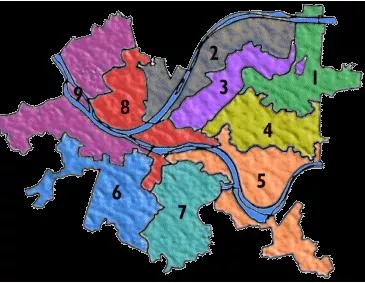Wednesday, September 12, 2012
Will public school board lose third majority-black district?
You knew it couldn't last. In an election season dominated by a presidential election, debates over voter ID, and the drawing of legislative boundaries, we've heard nary a peep from the city's often-fractious school board. But as the Pittsburgh Public Schools, too, must redraw the boundaries of its nine political districts, that may be about to change.
The reason? Demographic shifts may mean that without some massive shifting of district lines, black residents could lose some of their influence on the board.
The new districts are being drawn by the School District Reapportionment Commission, which is beginning to reckon with demographic changes since the 2000 Census. And changes to the black population may be the most vexing.
In recent decades, the number of African Americans living in the city has dwindled too, with many households moving to Penn Hills and points east. And the remaining black population has dispersed itself across the city more broadly, as you can see in this handy animation from Pitt's University Center for Social and Urban Research.
The result? According to the commission's preliminary analysis, while there have been population declines across the district, they've fallen especially hard on the three districts that had the largest black populations: Districts 1 (held by Sharene Shealey), 3 (Thomas Sumpter) and 8 (Mark Brentley). Numbers released by the commission suggest that these three districts alone lost nearly 14,000 people — just under half of a total population loss of 28,273.

In fact, the majority-black districts now barely qualify as majority black. District 1, which was 56 percent black in 2000, is now just 47 percent black. District 3 has dropped from 60 percent black to 51 percent, and district 7 went from 59 percent to 53.
And those numbers actually overstate black voting strength, because they include all residents, including those not old enough to vote. When the commission crunched the numbers on residents age 18 and older, not one of the districts has a majority of black voters. Arguably, that's especially problematic given that a majority of the kids attending those schools are black.
Ordinarily the most obvious solution here would be to simply rebalance districts, shifting district boundaries around to include nearby neighborhoods to bolster population in districts that have lost it. And in fact, districts 1, 3 and 8 all touch on the one district that has gained substantially in population: District 4, represented by Bill Isler. The problem? Isler's district, which is centered on the city's more affluent East End neighborhoods, has the smallest number of black residents to give; only 5 percent of its population is black. So absorbing some of his district would likely dilute the black vote in those districts even further.
Which raises a series of thorny questions. Should the commission rip up the existing map entirely, and try redrawing the boundaries from scratch? Legally speaking, there's nothing to stop it from doing so, but elected officials tend to oppose that kind of wholesale change. Community groups aren't always crazy about it either.
So, is it perhaps time to drop the idea of having three mostly-black districts? Would it be better, for purposes of black representation, to have two districts with strong black majorities, or try to cobble three districts in which blacks may constitute a bare majority? When you consider that blacks typically vote at lower rates than whites, in such districts there may not be a black majority on Election Day at all.
Such questions — at a time when voter ID bills are already generating debate over black disenfranchisement — could get ugly, as the commission itself seems aware.
This afternoon, commission co-chair Shawn Carter (whose day job is aide to City Councilor Ricky Burgess) sent an e-mail to community leaders, inviting them to a Sept. 18 meeting of the commission to discuss the issue:
As you may ... know, since 1985, the Pittsburgh Board of Public Education has had three (3) majority-minority districts, districts where African-American residents constitute the majority of the population ... Having applied the 2010 Census population data to the school district’s current boundaries raises some concerns.
... Given what the preliminary data reveals, the School District Reapportionment Commission unanimously decided at its' meeting last night to take no final action redrawing these boundaries prior to extensive conversation and input from African-American community leaders and organizations that represent the African-American community.
Good luck with that, folks!









